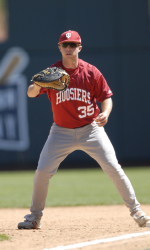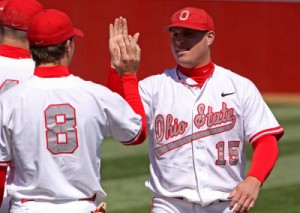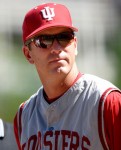Clash Of Last Year’s Champs On Tap
Ohio State was last year’s regular season Big Ten champion, while Indiana won the conference’s postseason tournament. Chris Webb from Buckeyestatebaseball.com has provided us with an extensive preview of this weekend’s series in Columbus, OH as well as a Q & A with Indiana head coach Tracy Smith. Next week Chris and I will record a podcast to talk about this series as well as other key Big Ten happenings.
From here through the conclusion of the season, I’ll provide insight into a Big Ten weekend series here on CollegeBaseball360. – Chris Webb
After a season in which three teams advanced to Regional play in Indiana, Minnesota, and Ohio State, all eyes were on the Midwestern conference to see if the 10 schools can continue to make strides in closing the gap between a once-proud conference and the power conferences of the country.
Receiving the most off-season hype and buzz was the Ohio State Buckeyes. After advancing to the finals of the Tallahassee Regional, the Bucks were ranked as high as 14th in the preseason polls, receiving the lofty ranking by Collegiate Baseball. With 8 everyday starters returning to the lineup and All-American Alex Wimmers anchoring the pitching staff, Ohio State appeared to be the team to return the Big Ten to Omaha.
After a 17-8 start, which has seen inconsistent play throughout, Ohio State has fallen from every ranking and hope the upcoming weekend spurns them into second-half success, playing baseball worthy of a team headed to Omaha.
Once the crown jewel of Northern ballparks, Bill Davis Stadium is now in it’s 14th season as the on-campus home for Ohio State. This weekend Bill Davis welcomes coach Tracy Smith and his Indiana Hoosiers for a key conference clash.
While Ohio State was the Big Ten regular season champion a year ago, Indiana ran through the field in the six-team Big Ten Tournament, held just minutes from Bill Davis at Columbus’ Huntington Park, the home of the AAA Columbus Clippers. In winning the postseason tournament, Indiana advanced to their second-ever NCAA Regional. While the Hoosiers went two-and-que in the Vanderbilt Regional, proof was shown that under Smith, Indiana is not far from becoming a regional power.
With two of the top contenders for the 2010 Big Ten crown squaring off, here is a look within the series.
Indiana Hooisers (14-13 overall 1-2 Big Ten)
@
Ohio State Buckeyes (17-8, 2-1)
Expected Rotation
Game 1 Friday April 9th, 6:35 PM:
LHP Matt Igel (0-3, 9.00) vs. RHP Alex Wimmers (6-0, 1.98)
Game 2 Saturday April 10th, 1:05 PM:
LHP Drew Leininger (4-1, 1.66) vs. RHP Drew Rucinski (3-1, 2.53)
Game 3 Sunday April 11th, 1:05 PM:
RHP Walker Stadley (3-2, 5.06) vs. RHP Dean Wolosiansky (2-3, 5.60)
Team Comparisons
Category…. Indiana…… Ohio State
RPI…………. 131…………… 114
SOS…………. 93……………. 212
IRS…………. 129……………. 89
Hitting…….. .329…………. .344
ERA………… 6.42………….. 4.56
Fielding…… .963………….. .956
HR………….. 41………………. 20
2B…………… 59………………. 46
3B…………… 6…………………. 9
SLG………… .522……………. .479
BB…………… 93……………….. 99
SO…………… 197………………. 112
OBP…………. .404…………….. .412
SB……………. 36-54………….. 13-23
OBA…………. .306…………….. .311
SO…………….. 174………………. 181
BB…………….. 124………………. 78
H………………. 294………………. 283
XBH………….. 90………………… 50
WHIP……….. 1.74………………. 1.63
Saves………… 4…………………… 7
About Indiana
The Hoosiers are coming off of an weekend series versus Michigan where the Wolverines took 2 of 3 on the road winning the first two games 16-10 (10) and 6-4. However the lasting thought of that series is the 26-6 shelling Indiana put on the Maize & Blue in Sunday’s getaway day.
A midweek win over Ball State brought Indiana above .500 for the first time all season.
Leading the way offensively for Indiana is the Big Ten’s version of the Bash Bothers in Jerrud Sabourin and Alex Dickerson. Sabourin leads the Hoosiers with a .480 average (59-for-123) with six home runs and 31 RBI. Behind him in the lineup as IU’s cleanup hitter is Dickerson with a .444 average ( 52-for-11), 10 doubles, and a Big Ten leading 12 home runs in route to 39 RBI.
Five other regulars are batting north of .300 to give Indiana its lofty .329 team average. Indiana is aggressive on the bases, and though Sabourin and Dickerson provided powerful bats, the Hoosiers are balanced enough to string off runs going station to station.
On the mound Indiana once again touts an impressive pitcher who will via for Wimmers in the Big Ten Pitcher of the Year race. On the strength of a consecutive scoreless innings streak that reached more than 25 innings, south Drew Leininger is 4-1 with a conference leading 1.66 ERA with 30 strikeouts and nine walks in 43.1 innings. Chris Squires is the Hoosiers’ closer coming in with four saves, a 3.74 ERA, and 2-1 record.
About Ohio State
Ohio State returns home after winning a weekend series in the Windy City against Northwestern. Wins of 11-1 and 11-6 where sandwiched by an 8-2 loss to the Wildcats to give the Bucks it’s 2-1 weekend. In playing just their second game at home of the year, Ohio State defeated Xavier on Wednesday to improve to 17-8 on the year.
While Ohio State enters the weekend with the Big Ten’s top hitting team, and second-best pitching staff, the Buckeyes have yet to string together a series of games where both aspects are in sync. Also leading to the team’s inconsistencies is the performance in the field. A fielding mark of .956 has led to 32 unearned runs crossing the plate for the Bucks’ opposition.
As expected the pitching staff is led by Wimmers who looks to collect his second-consecutive Big Ten Pitcher of the Year award. Drew Rucinski steps into the rotation after starting the season as Ohio State’s closer, the Buckeyes #2 pitcher leads the team with four saves in a sign of his conversion.
Offensively Ohio State boasts the Big Ten’s reigning Player of the Year, in catcher Dan Burkhart, giving Ohio State one of the nation’s best battery. Burkhart (.378, 18 RBI) the 3-hole hitter, is surrounded in the lineup by centerfielder Michael Stephens (.384, 6 HR, 23), first baseman Ryan Dew (.368, 3, 23), outfielders Zach Hurley (.373, 5, 26), and Brian DeLucia (.384, 4 21) as the team’s main power source. Infielders Cory Rupert (.400), and Cory Kovanda (.390) set the table for the Buckeyes balanced lineup.
Series History
Ohio State leads the series, 154-98, winning 15 of the 27 conference meetings. Last year the two split two meetings. Ohio State won a non-conference game in Florida 2-0. Indiana won 13-3 in the Big Ten Tournament from Huntington Park. The last series victory for Indiana came in 1996.
Key Matchup
Ohio State starters versus Indiana 3-4-5 hitters. Michael Early (.321-4-14) joins Sabourin and Dickerson as the conference’s most potent middle of the order. Most important is the fact that Sabourin and Dickerson are left-handed hitters which pose a threat to Ohio State’s all right-handed rotation. Obviously if these three are clicking things are in Indiana’s favor. If the Bucks can keep the trio to a .300 average or lower, the Bucks are well on their way to a weekend series victory.
Special Feature: Q&A with Indiana’s Coach Tracy Smith
CW: By now you’re probably tired of talking about it, but last year’s team lost a lot of talent. When a coach has such a removal of talent due to early-entrees leaving via the draft, does the program feel like it’s starting over in a way? Are losses like that “projected” and planned around in recruiting to keep the cupboard as full as possible?
TS: Some were projected. We planned to lose the five top 10-round guys, but the ones we did not plan for were the two that signed in the 30-something rounds. We didn’t see that coming until the very end of the season and those are the ones that have impacted this year the most because both those kids were to be in our top 3 in the rotation.
Now, add the injury to Monar the first weekend, we have been without our projected top 3 starters all year. Pretty tough on us, but we have found a way to win some games anyway.
CW: Perhaps an effect of some of the departures is having your son, Casey, early-enroll and in essence play Division I baseball during his senior year of high school.
Where there times before the process when you had to approach the situation different as a parent and coach? And now is the joy of coaching your son one of the biggest thrills of your coaching tenure?
TS: We knew we were going to be thin when O’Gara and Dunning signed late, but it wasn’t until we saw it with our own eyes in the fall did we realize just how thin we were.
Casey was being recruited by a couple of other schools, and once he decided IU was where he wanted to go I started to get this idea of bringing him early. He is a pretty smart kid, and has been around my programs all his life, so I think he saw the opportunity this year which led to his decision.
Coaching your kid is a joy and a challenge at the same time. Given the fact that he decided on the mid-year matriculation into IU so late, we elected not to put him in the dorms. Yes, he is living at home this semester, and this is the challenge I am referring to. If he screws up he not only gets it at school, but he gets it at home and that has made for some interesting dinner conversations.
I have jokingly said that if we are speaking with each other by the end of the year that will be a major accomplishment. All kidding aside, I am thrilled to be coaching my own kid. Far too often in this business we (coaches) invest a significant amount of time developing other people’s kids so it is nice to give your own some of that time.
CW: Speaking of the pitching staff, are you able to update the status of Monar?
TS: He is working his way back slowly. We hope we can get him back at some point, but I am not counting on it.
CW: In stepping in for Monar as the #1 pitcher, Leininger appears to be having an “Arnett-type” year where an outstanding season seemingly comes from nowhere.
What did you see from Drew before this season that an outbreak like this wasn’t out of the question? What so far this season has impressed you the most with his performances?
TS: I would be lying to you if I said I thought he was going to be having this type of season, but we always thought he could have success at this level. He has made some changes to his delivery that have really helped him.
You take that and add that to his already tough mindset and smooth delivery, maybe we shouldn’t be surprised. His consistency has been very impressive to me. He locates his pitches well and has consistently hit spots.
CW: Looking at the bats, you’re middle of he line-up is anchored by Sabourin and Dickerson. As the two had very solid 2009 campaigns, as a coach was there a lot of instruction needed for the duo to continue to excel?
Or was it a matter of letting good players be good players and only a matter of time before they picked up where they left off in 2009?
TS: Honestly, I have always believed coaches give themselves too much credit when it comes to players performing well. At IU, we try to instill an attitude of ownership in our kids. If you do well, take the credit. If you do poorly, don’t start pointing fingers.
So with these two, we pretty much give them an environment to develop their already extraordinary talents. Sure, as a coach you make some changes or suggestions that you think will help them, but for the most part if you have a player (or players) like these guys that already have a pretty good understanding of theirs swings, you just set up your bucket of balls behind the L-screen and feed them strikes during BP, the rest pretty much takes care of itself.
CW: Who are some of the players outside of those two that have really played well and filled in for the collective holes left by Josh Phegley, Evan Crawford, Kip Schultz and company?
TS: Freshman Micah Johnson has performed very well. He has provided the power we lost with Schultz and the speed we lost with Crawford. He is a very good player. Mike Earley is starting to give us more consistent at-bats, and from a senior that is what you expect. He also brings a toughness that you would love to see in all your players.
With Phegley, you had a catcher that understood the game. Coming into the year, we had 3 catchers that all bring a little something different to the table. The time we started playing more consistent baseball coincided with the time Dylan Swift took over behind the plate. He may not have the offensive numbers of some of the other guys, but he does a great job of handling our very immature staff during games.
CW: You have been as vocal as any coach in regards to the NCAA’s Universal Start Date and when it should be. Now that we’re in year two, what are your thoughts on the process after having it in a 13-week, and 14-week format?
TS: First, I am impressed that you knew I was vocal about this. I don’t mind the 14-week format, but the additional week was put on the “wrong” end of the season. By adding the additional week on the front end of the season, the NCAA has spoken loud and clear with regard to what it thinks about the schools playing baseball in the north – they don’t really care.
There is no other sport (outside of softball) that has the competitive disadvantages present like college baseball. The advantages and disadvantages, depending on what part of the country you are from, have a HUGE impact on your opportunity for post season play.
I don’t have enough time to give all the reasons, but clearly by adding the week to front of the college baseball season, the rich just got richer!
CW: There was a vote to go back to a 13-week schedule if the 14th week was not added on the back end. Why was that the approach being taken? Doesn’t a 13-week schedule hinder northern programs as much as southern in a compacted schedule?
Or was it just a matter of, we’re not having a 14th week at the front end until Hell freezes over?
TS: We, northern schools, have been dealing with schedule compaction as long as we have been coaching. We were used to it. But, when you add the week on the front end you have eliminated any chance for northern schools to schedule more home games.
More home games usually means a better chance to win. I have always said the term “home field advantage” was created for a reason. By adding the week on the front end, it ensures more road games for the northern schools, thus adding the potential for more RPI points to already inflated RPI numbers of southern conferences.
Many would argue that I am just complaining, and that the baseball is better in the south. Well, that may be true (I don’t agree), but I would like to see how some of these schools would perform early in the season if they were practicing on gym floors with little, or in most cases, no practice time on baseball fields.
I think if guys in the south experienced what the coaches in the north face year in and year out, then maybe they would be more sympathetic to our cause. I doubt it though, because they are at such a competitive advantage right now, why would they want to level the playing field. You got me going, didn’t you?
CW: Now that you are going… Discuss the current state of the Big Ten. It was mentioned last year following the Big Ten Tournament where four teams have had hopes of a Regional selection, with Illinois ultimately falling short, that it is ever-improving.
While on paper the Big Ten appears down from a year ago, what does it say that a program like Michigan State is on the rise as well as your continuing of building the Indiana program?
With OSU, Michigan, and Minnesota as established programs, do you feel the Big Ten is on the verge on taking the next step and perhaps narrowing the gap on the power conferences, and what has led to the revival?
TS: Well, I think the gap is closing. You have a lot of schools investing in their baseball programs, thus increasing expectations on winning.
However, what gets little discussion, and is probably this biggest reason the conference struggles to compete on a national level consistently is the fact that other conferences can over-sign. Teams in the Big Ten that recruit a significant number of high level talent have to lay back and wait to see how the draft plays out on how many guys they are going to lose.
Look what happened to Michigan last year. They win the Big Ten the year before, and fail to qualify for the tournament the next year. Is it because Coach Maloney was a great coach one year and bad one the next? No! He lost a ton of underclassmen and was not able to use their money until the players actually SIGNED a contract in the summer.
Who are you going to find that late to replace that kind of talent? You are not. We are experiencing a little bit of that ourselves this year.
Now, I do believe the Big Ten recognized this as a huge disadvantage for our league and instituted a rule change this year that allows schools to over sign up to one scholarship spread over two players.
It does help, but when other schools are over signing by 6-8 scholarships, the playing field is not even close to being even. The part that drives me nuts is nobody talks about this issue. Everyone wants to talk about weather, and huge stadiums, etc., as being the things the hold our conference back, but it’s not. The issue of over-signing is the real problem.
My friends who coach at southern schools laugh when I tell them that we can’t over-sign kids until our underclassmen physically sign a contact. They are like, “how in the heck do you guys recruit?” I have my response down to a science now, I put my hands behind my back and say, “like this.”
That said, I am not saying I agree with over-signing to the level most southern do it, because it can create some ugly scenarios where kids are “run off.” Again, too many reasons and not enough time to respond. But what I would like to see is some consistency with regard to the issue of over-signing.
I like the limits our conference has put on over-signing. Now, if we could get the rest of the country to buy into the Big Ten Conference’s rules, wouldn’t if be great? However, I say again, why would they? They are at too much of a competitive advantage under the current system to want to change.
As someone who is trying win every game I play, I guess I understand their position. But if the NCAA wants to do what is “right,” it will address the issue of over-signing, and adopt legislation that truly benefits our student-athletes all the while creating a more competitive environment for all of college baseball, not just some of it.
Alright, I am off my soap box.




